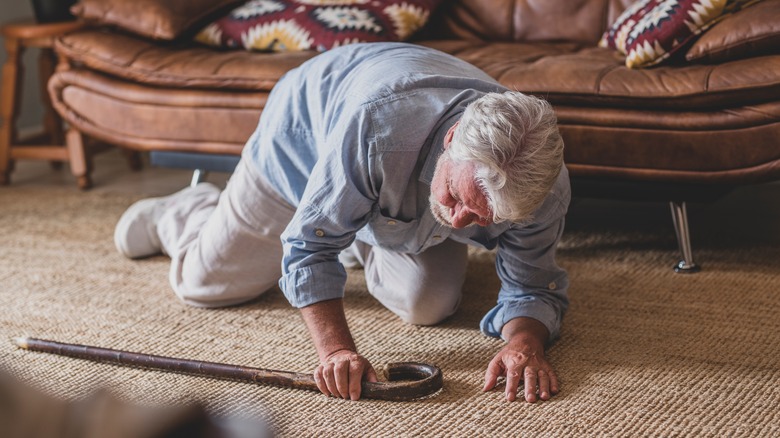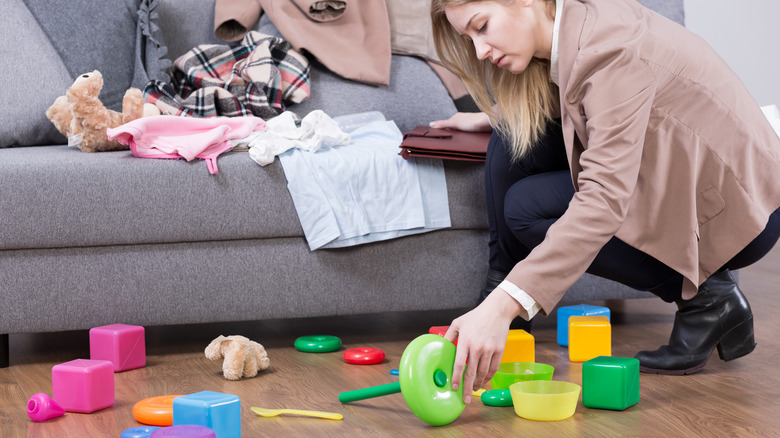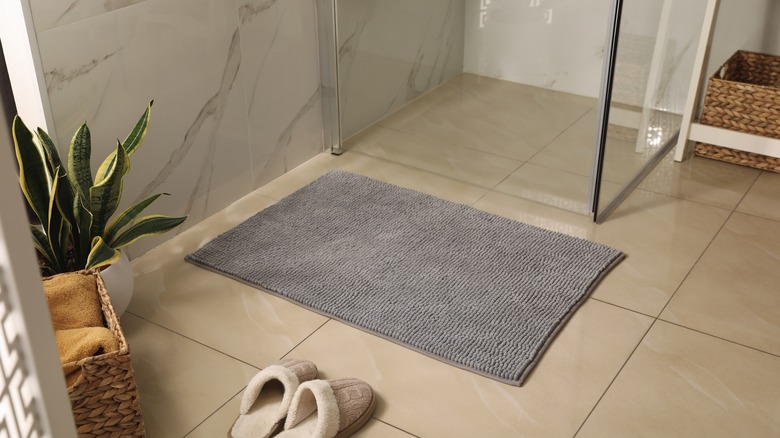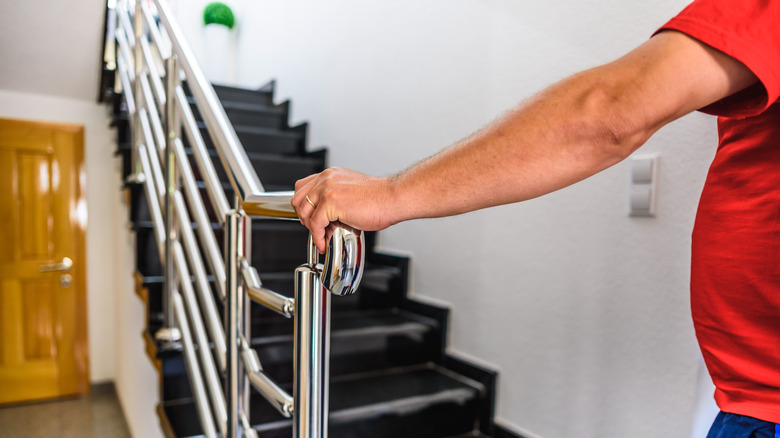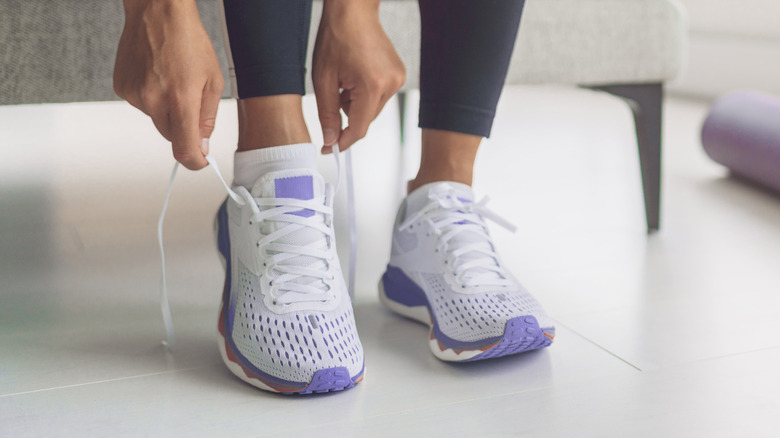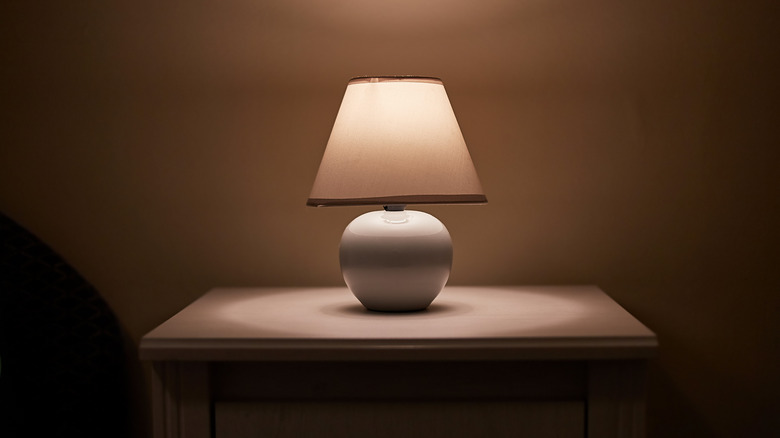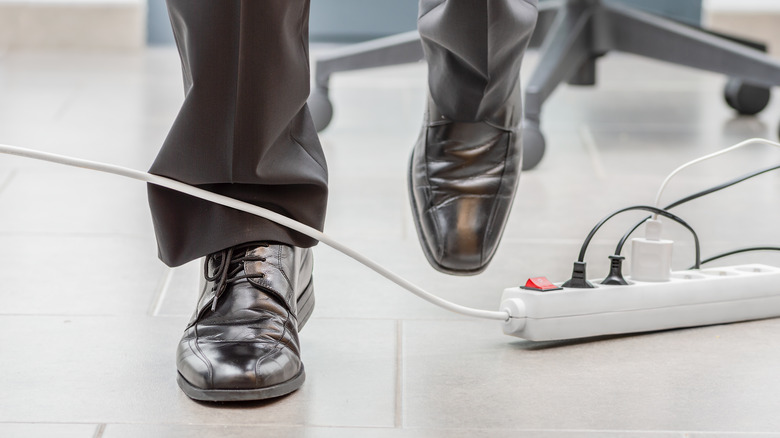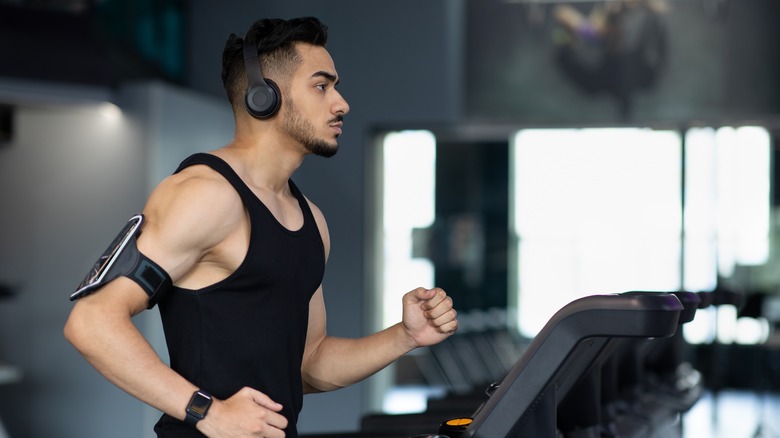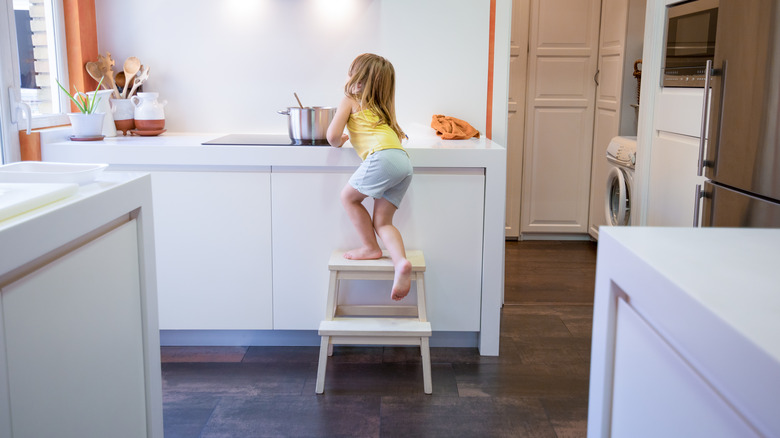The Best Ways To Prevent Falling In Your Home
Falling in the home is something we often think of as a problem for the elderly — but falls don't just affect seniors. They can happen to anyone, at any age. According to the World Health Organization, "Falls are the second leading cause of unintentional injury deaths worldwide." Falling in your home is something you probably don't think will ever happen, but you can't be too safe when it comes to preventing injuries. This is especially true if you have young children or elderly folks in your home — but it applies to people of all ages.
There are many things that can contribute to falling, such as slippery floors, loose carpets, poor lighting, and cluttered rooms. Falls can also be caused by underlying health conditions like balance disorders or muscle weakness. However, there are some measures you can take to prevent falls in your home. Let's take a closer look at some of these.
Keep your floors clean and free of clutter
Although there are many factors that contribute to falling and hurting yourself at home, one of the most important things you can do to prevent falls is to keep your floors clean and free of clutter. A cluttered floor is a trip hazard, plain and simple. If you have items on the floor that you trip over, you are more likely to take a fall, according to Everyday Health. Even if you don't trip, a busy floor can be distracting and make it difficult to focus on where you are walking. If you have trouble seeing due to poor vision, a cluttered floor can make it even more difficult to avoid hazards.
In addition to trip hazards, a cluttered floor can also hide potential dangers. A small throw rug that you don't see can easily cause you to trip and fall. If there are electrical cords running across the floor, you could accidentally catch your foot on them and fall. Even something as innocuous as a pair of shoes left in the middle of the floor can be dangerous if you don't see the shoes and step on them wrong. This can be especially true for seniors, children, or anyone who has mobility issues, as they may have a harder time navigating a cluttered floor than you.
Use nonslip mats in your bathtub or shower
The bathroom is one of the most dangerous places in the house when it comes to falls. This is especially true for seniors, young children, and people with mobility disabilities who are more likely to slip and fall in a wet or slippery environment. One way to help prevent these kinds of accidents is to use nonslip mats in your bathtub or shower, according to HearGlow. These mats provide extra traction and can help keep you from slipping and falling.
In addition to using nonslip mats, there are other things you can do to reduce your risk of falling in the bathroom. This includes installing grab bars next to your toilet, keeping your bathroom floor clean and dry, and wearing shoes with good traction when you are in the shower or bathtub (via Kerovit). Keep your bathroom floor clear from clutter to avoid tripping hazards. You may also want to avoid oil-based products in the tub or shower, as these can leave a residue that can cause you to slip and fall.
Install handrails on all stairways
Handrails are an important safety feature in any home. They provide stability and support when ascending or descending stairs, and can help prevent falls. Whether your stairway is indoor or outdoor, installing handrails is a simple and effective way to improve the safety of your home, according to Elder. If you have young children or elderly family members living in your home, handrails are an absolute necessity. Children are often unsteady on their feet, and can easily lose their balance when going up or down stairs. Older adults may also be more prone to falls, and handrails can provide the extra support they need to stay safe.
Handrails can also improve the aesthetics and value of your home (via White Aluminum). In addition to the safety benefits, handrails can add a touch of sophistication to your stairway. They come in a variety of materials, colors, and styles, so you can find the perfect look to complement your home's décor. Installing handrails is a relatively simple and inexpensive project that can have a big impact on the safety and look of your home.
Wear shoes with good traction while inside
Walking around your home in shoes with good traction, regardless of how old you are, can help you avoid slips and falls, according to Henry Ford Health. This is especially important if you have hardwood floors, which can be slippery when they're wet or when you wear socks. Shoes with good traction can also help you keep your balance when you're carrying something or walking up and down stairs. If you're worried about slipping, consider wearing shoes with non-slip soles or investing in floor mats for your home.
Even if you're just walking from your bedroom to the bathroom, it's important to wear shoes with good traction because it only takes a split second for an accident to happen. If you're not paying attention and you slip, you could hit your head or break a bone. Wearing shoes with good traction can help you avoid these kinds of accidents. When you're shopping for shoes, look for ones that have a rubber sole or deep treads, which will provide the best grip and help you stay safe when you're walking around your home.
Use a night light to help you see
There are many good reasons to have night lights around your home. They can help you see at night, avoid tripping and falling, and even deter burglars. Older adults can also benefit from night lights. As we age, our eyesight often deteriorates, making it difficult to see at night, and night lights can help older adults find their way around their homes and prevent them from tripping and falling (via Senior Safety Advice).
If you have young children, night lights can help them feel safe at night. Many kids are afraid of the dark, and a night light can help ease their fears. Night lights can also help prevent accidents. If someone gets up in the middle of the night to use the bathroom, a night light will help them find their way and prevent them from tripping over toys or furniture.
Night lights are relatively inexpensive and easy to install. They can provide peace of mind and help keep your family safe. You also don't have to worry about leaving them on all night, according to Project Perfect Home. As long as you use low wattage LED bulbs, you won't have an issue with the lights getting too hot after being left on for an extended period of time.
Keep electrical cords and other tripping hazards out of walkways
Your home is supposed to be a safe haven for you and your family. But if you don't take precautions, it can quickly become a hazard zone. One of the most common hazards in the home is tripping over cords or other objects in walkways (via Health Care Associates). Not only are electrical cords a tripping hazard, but they can also be dangerous if they're not properly insulated. If you live in an older home, make sure all of your electrical cords are up to date and in good condition. If you're not sure, ask an electrician to inspect them.
Another common tripping hazard is loose rugs or mats. These can be easily tucked under or moved out of the way to avoid accidents. If you have young children or pets, make sure to secure rugs so they don't slip and create a hazard. In the winter, ice and snow can build up on walkways and become a slipping hazard, according to Pettit Law Office. Keep your walkways clear of debris and salt them regularly to prevent accidents. By taking some simple precautions, you can make your home (inside and out) much safer for everyone.
Stay physically active
As we age, our risk of falling and sustaining an injury increases. But regardless of age, everyone is at risk of falling in their home and hurting themselves. There are many things that can contribute to a fall, such as poor vision, muscle weakness, balance problems, and medications that cause dizziness or drowsiness. While some of these factors can't be controlled, one of the best ways to decrease your likelihood of falling is to engage in regular physical exercise, per the National Institute on Aging. Staying active and strong improves your balance and strength, two factors that are crucial when it comes to catching yourself after slipping or tripping.
There are also plenty of other benefits of regular exercise. According to the Centers for Disease Control and Prevention, exercise can help reduce your risk of developing chronic diseases such as heart disease, stroke, and type 2 diabetes. It can also help improve mental health by reducing stress and improving cognitive function. And for older adults, staying active can help delay the onset of disabilities associated with aging — which can also contribute to falling. So not only does exercise help you avoid falls and injuries, it also has a host of other benefits that make it essential for maintaining your health as you age.
Move to one level
This isn't an option for everyone and really only needs to be considered by those who live with people at a high risk of falling, like young children and seniors. Having a one level home can help to prevent falls because there are no stairs for people to trip on. It also makes it easier to get around the house for those who have mobility issues (via Reuters). If someone does fall, there is less of a chance of serious injury if there are no stairs involved.
One level homes can also be more energy efficient because they require less heating and cooling, according to Realtor.com. They tend to be cheaper to build and maintain as well, and they're easier to keep clean. No dusting or vacuuming staircases means one less chore on your list. Of course, a one level home isn't right for everyone, but if you have the option, it might be worth considering, especially if you have young children or seniors living with you. Falls can be serious, and preventing them is always the best course of action.
Keep heavily used items within reach
Heavily used items in your home should be kept within reach to avoid using stools or chairs to reach them. This is because stools and chairs can increase the risk of falls for people of all ages. All it takes is a misstep or loss of balance to fall hard onto the floor. Although storage can be a battle for many families, try to keep items that you reach for almost every day within reach from the floor. This may include things like laundry detergent, dishes, and kitchen appliances.
While using step stools and chairs to reach something is sometimes necessary, these items should be avoided when possible. They are particularly dangerous for children, who often need help reaching items since they are small (via Nemours KidsHealth). Seniors or people with mobility disabilities who have trouble keeping their balance are also at a higher risk of falling from a stool, stepladder, or chair. You can also encourage everyone in your home to ask for help if they need to reach something.

